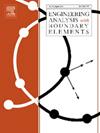求解扩散-对流问题的新型直接插值边界元法公式
IF 4.1
2区 工程技术
Q1 ENGINEERING, MULTIDISCIPLINARY
Engineering Analysis with Boundary Elements
Pub Date : 2024-10-17
DOI:10.1016/j.enganabound.2024.105992
引用次数: 0
摘要
处理平流输运项的能力对大多数数值技术的性能构成了挑战,因为随着平流输运项相对量的增加,其精度会明显降低。最近,出现了一种称为直接插值(DIBEM)的新边界元技术,其主要特点是对剩余域积分的整个内核进行近似。DIBEM 模型已成功应用于多个标量场问题,最近又被应用于某些扩散-对流问题,其精度优于二元互易公式(DRBEM)。使用 DIBEM,由于其矩阵运算简单,可以在更低的计算成本之外,对更高佩克莱特数的流动做出更广泛的精确响应。这些优势都归功于 DIBEM 的概念,即采用简单的插值程序来逼近平流域积分的核。然而,人们注意到,在一些速度场存在空间变化的物理场景中,DIBEM 的精度并不像在其他应用中观察到的那样高。因此,本研究提出了一种新的 DIBEM 模型,使积分方程包括空间导数的显式计算,并同时求解发散速度场的变化(如果该变化不为零)。相反,为了扩大数值比较范围,还加入了反应项和源项。因此,在所提出的示例中,两种 DIBEM 模型(标准模型(DIBEM-S)和新的所谓替代模型(DIBEM-A))的结果与 DRBEM 以及现有的分析解法进行了比较。本文章由计算机程序翻译,如有差异,请以英文原文为准。
A novel direct interpolation boundary element method formulation for solving diffusive–advective problems
The capability of dealing with the advective transport term constitutes a challenging issue for the performance of the majority of the numerical techniques, which significantly lose their precision with the increasing in the relative magnitude of this term. Recently, a new boundary element technique called direct interpolation (DIBEM) has emerged, mainly characterized by the approximation of the entire kernel of the remaining domain integrals. The DIBEM model has been successfully applied to several scalar field problems and recently applied to certain diffusive–advective problems with superior accuracy compared to dual reciprocity formulation (DRBEM). Using DIBEM, a broader range of precise responses for flows with higher Peclet numbers can be reached beyond a lower computational cost due to the simplicity of its matrix operations. These advantages are due DIBEM concept that employs a simple interpolation procedure to approximate the kernel of the advective domain integral. However, it was noticed that in some physical scenarios with spatial variation in the velocity field, the accuracy of DIBEM did not have the same quality observed in other applications. Therefore, this work presents a new DIBEM model so that the integral equations include the explicit calculation of spatial derivatives and simultaneously solve the variation of the divergent velocity field if this is not zero. Conversely, reactive and source terms were also included to expand numerical comparisons. Thus, in the proposed examples, the results of two DIBEM models, the standard (DIBEM-S) and the new, so-called alternative model (DIBEM-A), are compared with DRBEM and also with available analytical solutions.
求助全文
通过发布文献求助,成功后即可免费获取论文全文。
去求助
来源期刊

Engineering Analysis with Boundary Elements
工程技术-工程:综合
CiteScore
5.50
自引率
18.20%
发文量
368
审稿时长
56 days
期刊介绍:
This journal is specifically dedicated to the dissemination of the latest developments of new engineering analysis techniques using boundary elements and other mesh reduction methods.
Boundary element (BEM) and mesh reduction methods (MRM) are very active areas of research with the techniques being applied to solve increasingly complex problems. The journal stresses the importance of these applications as well as their computational aspects, reliability and robustness.
The main criteria for publication will be the originality of the work being reported, its potential usefulness and applications of the methods to new fields.
In addition to regular issues, the journal publishes a series of special issues dealing with specific areas of current research.
The journal has, for many years, provided a channel of communication between academics and industrial researchers working in mesh reduction methods
Fields Covered:
• Boundary Element Methods (BEM)
• Mesh Reduction Methods (MRM)
• Meshless Methods
• Integral Equations
• Applications of BEM/MRM in Engineering
• Numerical Methods related to BEM/MRM
• Computational Techniques
• Combination of Different Methods
• Advanced Formulations.
 求助内容:
求助内容: 应助结果提醒方式:
应助结果提醒方式:


